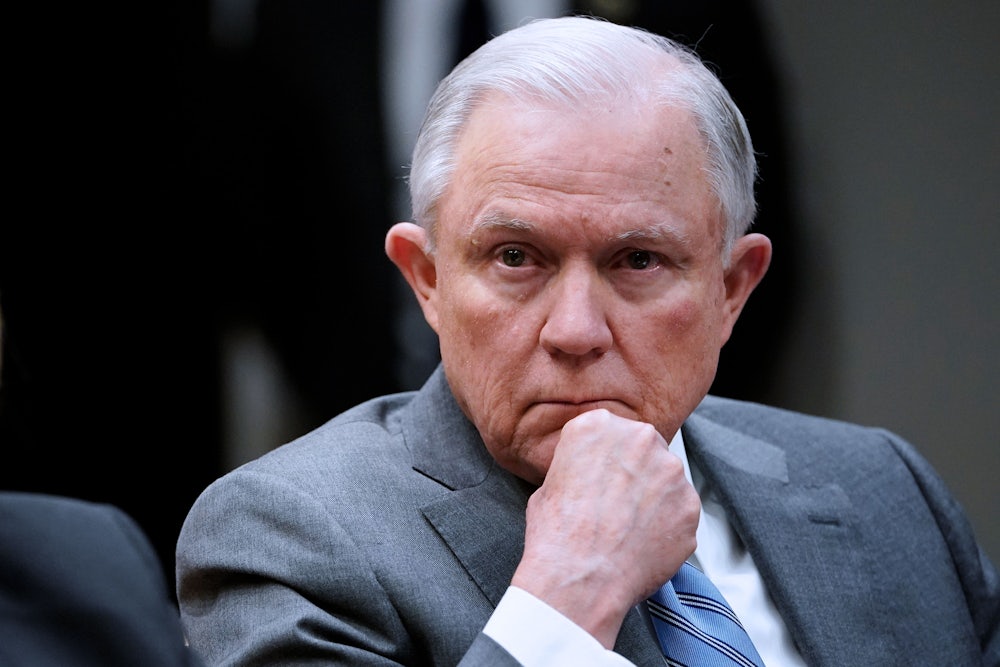In a speech Monday in Manchester, New Hampshire, President Donald Trump enthusiastically backed capital punishment as a tool to fight the opioid epidemic. “If we don’t get tough on the drug dealers, we are wasting our time,” he said. “And that toughness includes the death penalty.” Now, Attorney General Jeff Sessions is trying to put Trump’s call into practice.
In one-page memo dated Tuesday, Sessions instructed U.S. attorneys nationwide to be more aggressive when prosecuting any drug-related crimes. In addition to the usual tools available to federal prosecutors, he urged them to consider “the pursuit of capital punishment in appropriate cases.” To that end, he noted a few specific federal offenses where Congress already authorized the death penalty as a punishment.
“I strongly encourage federal prosecutors to use these statutes, when appropriate, to aid in our continuing fight against drug trafficking and the destruction it causes,” Sessions wrote.
Trump’s love affair with capital punishment runs deep, and Sessions’s tenure at the Justice Department is essentially a one-man counterrevolution against the bipartisan consensus on criminal-justice reform. Both men share a similar impulse when it comes to crime and punishment: Harsher policies against defendants indicate toughness on crime, while less punitive measures indicate weakness. In that Paleolithic worldview, no policy could epitomize strength more than one that takes the defendant’s life.
Not everyone in the Justice Department shares that mindset, however. Implementation of Sessions’s memo will fall to U.S. attorney’s offices across the nation, where federal prosecutors may react with varying levels of enthusiasm to the attorney general’s instructions. “The devil is in the details, and the devil here is how folks on the ground respond,” Douglas Berman, an Ohio University law professor, told me.
It’s unclear how many new death sentences could be sought if prosecutors embrace the memo’s approach. The federal government pursues roughly 20,000 drug-related prosecutions each year, Berman noted, and only “a tiny percentage” would qualify under the statutes that Sessions listed (“certain racketeering activities,” “the use of a firearm resulting in death during a drug trafficking offense,” “murder in furtherance of a continuing criminal enterprise,” and “dealing in extremely large quantities of drugs”). If even 0.1 percent of those cases involve crimes that would now be tried as capital offenses, it would be a sizable increase in the number of death-penalty cases sought by federal prosecutors each year.
That raises another limiting factor: the scarcity of manpower to pursue capital cases. ”It’s unclear how much of this is a symbolic gesture or how much it will yield an infusion of resources and actual prosecutions,” Carol Steiker, a Harvard University law professor, told me. Death-penalty cases are arduous for prosecutors and defense attorneys alike. The prosecutions pass through far more procedural hurdles than other criminal cases, and if the jury hands down a death sentence, both sides immediately enter a lengthy appeals process.
These constraints are one reason why federal death-penalty cases are exceedingly rare to begin with. Steiker noted that only three federal executions have taken place since the Supreme Court revived the death penalty in 1976. Only one involved an offense cited by Sessions, which became law after Congress passed and President Bill Clinton signed the 1994 crime bill. “1994 was kind of a high-water mark for death penalty support in the United States,” she said.
“There is no doubt, in my view, that if the death penalty is used in any federal setting that doesn’t involve a direct intentional killing, there will be constitutional challenges,” Berman said.
How the justices would rule on such a case is hard to predict. Justice Anthony Kennedy has been the swing vote on death-penalty cases over the last two decades. He also wrote the majority opinion in Kennedy v. Louisiana, the landmark 2008 case that abolished capital punishment for virtually all crimes in which the victim didn’t die. In that case, Kennedy specifically declined to address whether the ruling should apply to what he called “crimes against the state,” which included treason, espionage, terrorism, and “drug kingpin activity.”
Whether the Eighth Amendment, which forbids cruel and unusual punishments, applies to the execution of certain types of drug dealers therefore remains an open question. “Drug crimes are simply not in the same ballpark as treason and terrorism in terms of the Supreme Court’s overall project to restrict capital punishment to the worst-of-the-worst offenders,” Steiker said.
A notable window into the Kennedy’s thinking on drug crimes, Berman added, comes from the 1991 case Harmelin v. Michigan. Kennedy sided with the court’s majority to rule that a defendant’s sentence of life without parole for possessing more than 650 grams of cocaine didn’t violate the Eighth Amendment. In a separate concurrence, the justice wrote that the defendant’s claim that his crimes were “nonviolent and victimless” were “false to the point of absurdity.”
“To the contrary, [the defendant’s] crime threatened to cause grave harm to society,” he argued, writing that research showed drug users “may commit crime because of drug-induced changes in physiological functions, cognitive ability, and mood,” or because they need to obtain more money to further their habit. These remarks came at the height of a crime wave in the late 1980s and early 1990s, so it’s unclear if Kennedy’s views on the matter have changed in the intervening years.
The long appeals process in federal death-penalty cases means any prosecutions brought because of Sessions’s memo could be reviewed by Supreme Court justices who have yet to be appointed. “You have to envision a court five to ten years from now,” Berman said.
